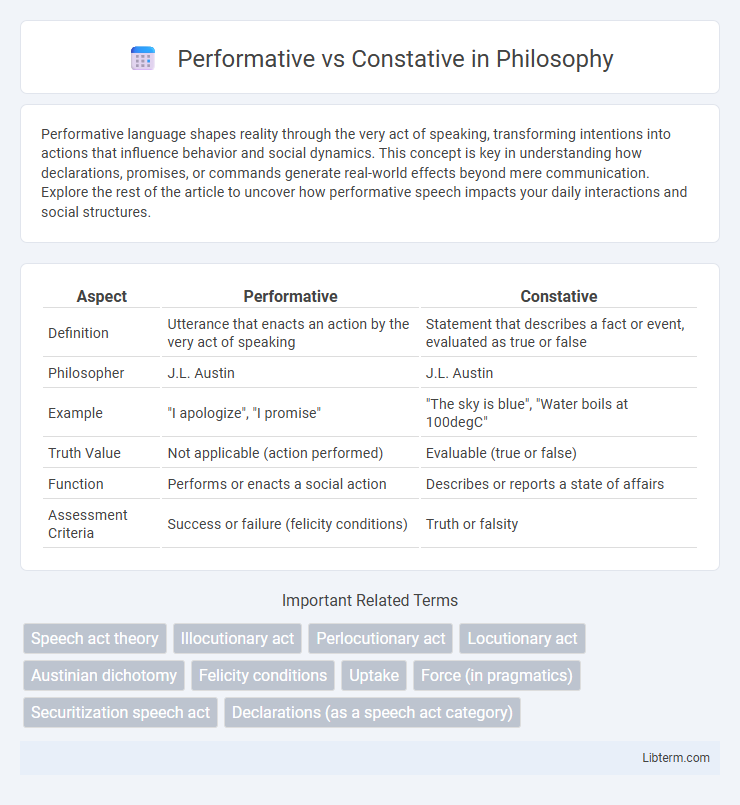Performative language shapes reality through the very act of speaking, transforming intentions into actions that influence behavior and social dynamics. This concept is key in understanding how declarations, promises, or commands generate real-world effects beyond mere communication. Explore the rest of the article to uncover how performative speech impacts your daily interactions and social structures.
Table of Comparison
| Aspect | Performative | Constative |
|---|---|---|
| Definition | Utterance that enacts an action by the very act of speaking | Statement that describes a fact or event, evaluated as true or false |
| Philosopher | J.L. Austin | J.L. Austin |
| Example | "I apologize", "I promise" | "The sky is blue", "Water boils at 100degC" |
| Truth Value | Not applicable (action performed) | Evaluable (true or false) |
| Function | Performs or enacts a social action | Describes or reports a state of affairs |
| Assessment Criteria | Success or failure (felicity conditions) | Truth or falsity |
Understanding Performative and Constative Utterances
Performative utterances are speech acts that enact an action simply by being spoken, such as "I apologize" or "I promise," where the utterance itself performs the function it describes. Constative utterances, in contrast, describe a state of affairs and can be evaluated as true or false, like "The sky is blue" or "She is running." Understanding the distinction hinges on recognizing that performatives change reality through speech, while constatives report on reality without altering it.
Defining Performative Speech Acts
Performative speech acts are utterances that accomplish an action simply by being spoken, such as "I apologize" or "I promise," where the speech itself performs the act. Unlike constative statements that describe or report facts, performative acts change the social reality and require conditions like authority and appropriate context to be valid. J.L. Austin introduced this concept in his theory of speech acts, emphasizing the role of performatives in language as actions rather than mere statements.
What Are Constative Utterances?
Constative utterances are statements that describe a situation or state of affairs and can be evaluated as true or false based on factual accuracy. They function primarily to convey information or assert facts, such as "The sky is blue" or "She is reading a book." Unlike performative utterances, constatives do not perform an action through speech but rather report or observe reality.
Historical Background: Austin and Speech Act Theory
J.L. Austin introduced the distinction between performative and constative utterances in his 1955 lectures, laying the foundation for Speech Act Theory. Performative utterances perform an action through the act of speaking, such as "I apologize," while constative utterances describe a state of affairs and can be evaluated as true or false. Austin's work revolutionized the study of language by emphasizing the performative function of speech beyond mere description.
Key Features: Performative vs. Constative
Performative utterances actively accomplish an action through speech, such as promising or apologizing, whereas constative statements describe or report facts that can be evaluated as true or false. Key features of performatives include their reliance on context and speaker authority to be valid, while constatives are primarily judged on their truth value or accuracy. The performative's success depends on the speaker's intentions and social conventions, contrasting with the constative's emphasis on objective verification.
Real-Life Examples of Performative Utterances
Performative utterances are speech acts that perform an action simply by being spoken, such as saying "I apologize" to express an apology or "I promise" to commit to a future action. In real-life scenarios, judges declare verdicts by stating "I sentence you," which enacts the sentencing, while couples exchanging "I do" in wedding vows legally solemnize their marriage. These examples demonstrate how performative utterances function as both communication and action within social and legal contexts.
Everyday Use of Constative Statements
Constative statements describe facts or events that can be verified as true or false, making them essential in everyday communication for conveying information clearly and accurately. These statements, such as "The sky is blue" or "I have a meeting at 3 PM," allow individuals to share observations and report on the state of the world, facilitating understanding and decision-making. In contrast to performative utterances that enact an action by being spoken, constative utterances primarily function to assert or describe reality.
Misinterpretations and Overlaps in Practice
Performative utterances directly enact an action through speech, while constative statements describe facts or events; misinterpretations often arise when listeners treat performatives as mere descriptions, leading to confusion in legal or conversational contexts. Overlaps occur when constatives imply actions or commitments, blurring the boundary and causing difficulties in pragmatic analysis and communication clarity. Understanding the context, speaker intention, and cultural norms is essential to accurately distinguish between these speech acts and avoid practical misunderstandings.
Implications in Communication and Linguistics
Performative utterances directly enact an action by the very act of being spoken, such as "I apologize," which transforms communication into a form of social action with normative consequences. Constative statements describe facts or states of affairs that can be evaluated as true or false, serving primarily to convey information rather than to perform an action. Understanding the distinction between performative and constative speech acts is crucial in linguistics for analyzing how language functions pragmatically to influence social interactions and shape meaning beyond mere truth-conditional content.
The Continuing Debate: Are All Utterances Performative?
The debate over performative versus constative utterances centers on whether all speech acts inherently perform an action or merely describe states of affairs. J.L. Austin's theory distinguishes performative sentences as those that enact something by the very act of being spoken, such as "I apologize," whereas constative statements describe facts and can be judged true or false. Contemporary linguistics and philosophy explore if every utterance carries performative functions, suggesting that even constative sentences perform actions like asserting or promising within communicative contexts.
Performative Infographic

 libterm.com
libterm.com